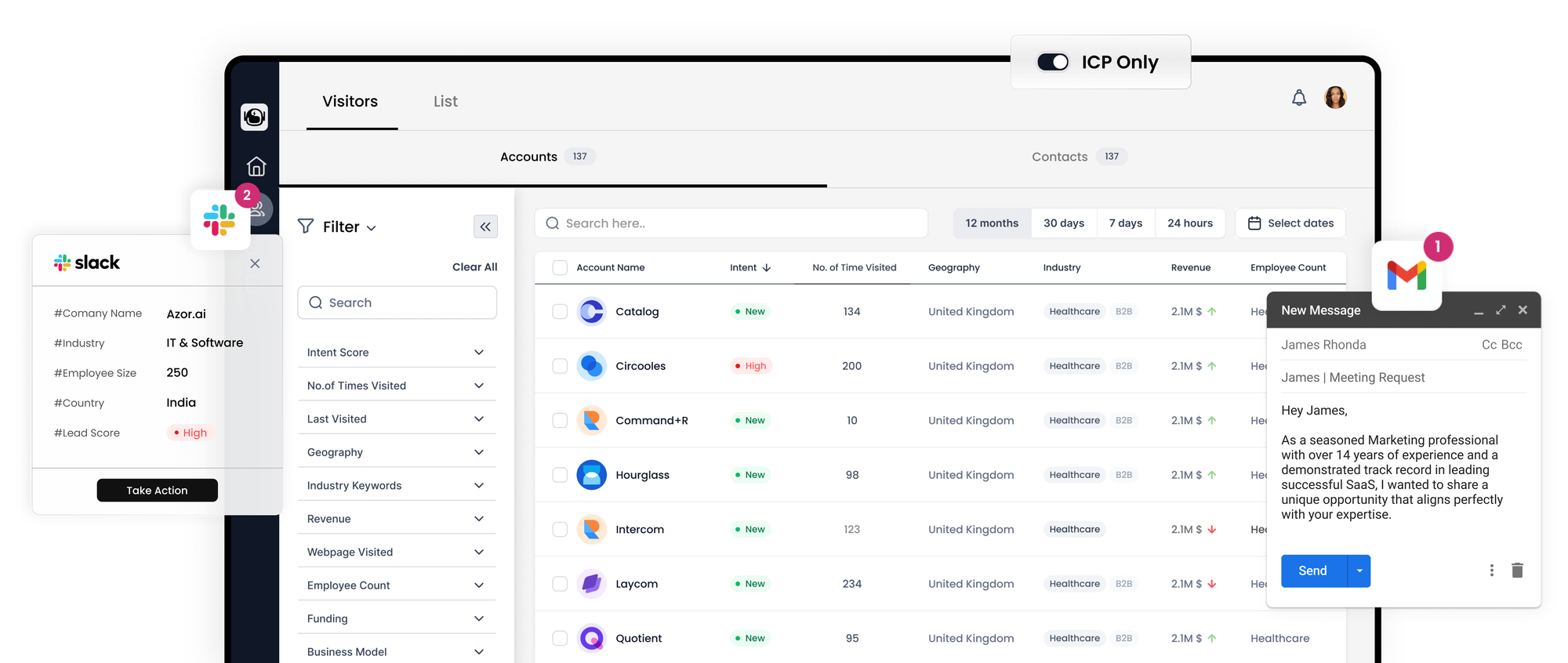What Constitutes B2B Lead Generation

B2B lead generation involves the strategic identification and cultivation of potential clients for your products or services. It's a foundational component of sales and marketing efforts in the B2B sector.
Generate 10x more demos with Revmonk.
The Significance of B2B Lead Generation
B2B lead generation is a cornerstone for business prosperity. It plays a pivotal role for sales and marketing teams and has a broad impact across the business. Prioritizing lead generation empowers your organization to:
- Identify your Total Addressable Market (TAM)
- Gather essential contact details
- Create a reliable sales pipeline
- Support content development
- Enhance brand visibility
Crucially, effective lead generation is synonymous with driving revenue when executed properly.
The efficacy of marketing campaigns hinges on the quality of lead generation data available to sales and marketing teams.
Inaccurate or incomplete contact information for B2B leads hinders Sales Development Representatives (SDRs) from making successful cold calls or dispatching targeted outbound emails. Similarly, when demand-generation marketers are equipped with flawed data about their target accounts, the challenge of crafting and disseminating content that resonates and converts is significantly amplified.
Beyond these operational uses, high-caliber B2B data is a keystone for analysis and forecasting. It establishes a foundation for KPIs and benchmarks at both individual and team levels, allowing businesses to quantify their efforts and outcomes. Insights gleaned from a thorough analysis of B2B data can be incredibly revealing. Business leaders are afforded the clarity to identify any shortcomings in their lead generation processes and adapt accordingly. The most adept B2B organizations maintain vigilant oversight of their data, integrating it into their strategic decision-making processes.
To streamline their operations, B2B companies often enlist the services of B2B data providers such as ZoomInfo or Cognism to procure sales leads efficiently.

Identify and reach out to visitors on your website, automatically with Revmonk.
Understanding B2B Leads in Lead Generation
B2B leads are essentially potential clients that are identified as suitable candidates for purchasing your company's products or services. They are recognized based on the likelihood that they would benefit from what your business has to offer.
B2B leads are classified into two main categories:
1. Marketing-Qualified Leads (MQLs):
These leads have engaged with your marketing efforts and show a high potential for becoming customers. Their qualification derives from interactions such as:
- Regularly visiting specific pages on your company website.
- Completing forms on your site.
- Downloading your business’s content.
- Registering for company events or webinars.
2. Sales-Qualified Leads (SQLs):
SQLs are MQLs who have moved further down the sales funnel and are ready to interact with your sales team. They are considered SQLs when they demonstrate a clear intent to purchase, which can manifest through:
- Conversations with your sales team over the phone.
- Interest indicated via emails or LinkedIn messages.
- Requests for more detailed information about your offerings.
- Inquiries about product demonstrations.
The orchestration of B2B Lead Generation:
Professionals in sales and marketing are typically responsible for B2B lead generation. They may operate independently or, more commonly, as part of a collaborative team.
For optimal performance, it is advantageous for the sales and marketing teams to work in tandem.
Sales
Sales teams dedicated to lead generation often comprise two distinct groups, each with specific roles:
- Sales Development Representatives (SDRs): This segment is tasked with finding, vetting, engaging leads, and arranging meetings.
- Business Development Managers (BDMs): These professionals are charged with performing product demos, finalizing sales, and generating company revenue.
Adopting this bifurcated approach provides several advantages:
- It ensures a robust lead generation pipeline, with SDRs setting the stage for BDMs to capitalize on opportunities.
- It allows each team member to concentrate on a single set of duties, fostering specialization and expertise.
- It lays out a clear path for career growth, with high-performing SDRs having the opportunity to advance to BDM roles.
Marketing Roles in B2B Lead Generation
The marketing segment dealing with B2B lead generation typically features two primary types of marketers, each with distinct marketing strategies and goals.
The categories are as follows:
1. Demand Generation Marketers:
These marketers look at the full spectrum of the lead generation revenue cycle. They are tasked with progressing leads through the stages of brand awareness, customer acquisition, and ultimately, converting them into brand champions.
2. Growth Hackers:
Aimed at rapidly scaling revenue with minimal expenditure, growth hackers are commonly found in early-stage startups. Their methodology is more experimental, often leveraging less scalable but innovative tactics to achieve quick wins.
Despite their distinct methods, both demand generation marketers and growth hackers share a reliance on data analysis and rigorous testing. This analytical approach underpins their strategies, ensuring they are always steering towards the most effective B2B lead generation outcomes.
B2B Lead Generation Execution
B2B lead generation spans across several key sales and marketing functions. Below, we describe the typical activities involved in generating B2B leads from a sales perspective.
Sales Activities
In the sales domain, the primary thrust of B2B lead generation involves outbound efforts, such as:
1. Cold Calling:
Sales Development Representatives (SDRs) initiate contact with potential leads by phone, pitching the merits of their offerings, and assessing the lead's interest and fit for further engagement. This approach can either be manual or supported by automated dialing systems. 📞
2. Outbound Emailing:
SDRs engage potential leads through targeted email outreach, aiming to spark conversations. Outbound emailing is typically streamlined using email automation tools to efficiently manage campaigns. 📨
3. Social Selling:
SDRs leverage social media platforms, predominantly LinkedIn in the B2B context, to connect with potential leads. They aim to build rapport and nurture relationships over time through consistent interaction. 📱
4. Sales Cadences:
A strategic sequence that integrates all the above methods—cold calling, emailing, and social selling—is known as a sales cadence. SDRs implement such cadences to boost response rates from potential leads. 📞📨📱
The endgame of these sales activities is to convince a lead to participate in a product demonstration, typically hosted by a Business Development Manager (BDM).
Marketing Strategies
Marketers tasked with B2B lead generation often employ demand generation tactics, which encompass a variety of strategic approaches:
1. Growth Hacking:
B2B marketers or growth hackers utilize inventive, cost-effective strategies to swiftly amplify demand and business expansion. These strategies may include promotional campaigns, referral programs, and providing valuable resources at no cost. 🚀
2. Content Marketing:
Marketers craft and distribute informative and valuable content tailored to their target audience. This content could manifest in numerous formats such as blog posts, videos, webinars, podcasts, and ebooks, all aimed at engaging potential leads. 📝
3. Account-Based Marketing (ABM):
Marketers pinpoint and focus on the key decision-makers within a particular organization, tailoring marketing initiatives to these specific individuals for a more personalized approach. 🎯
These marketing efforts are designed to capture and nurture leads at various stages of the B2B marketing funnel, whether the objective is to draw in new prospects or guide existing leads towards a purchase decision.
What technologies enhance B2B lead generation?
Modern sales and marketing teams greatly benefit from technology when it comes to B2B lead generation. Routine sales tasks such as cold calling and sending outbound emails can now be streamlined with automation tools. Similarly, marketing endeavors like content creation for blogs and social media management depend on advanced content management systems and robust online platforms.
Interactions with potential B2B clients are meticulously recorded in Customer Relationship Management (CRM) systems. Analyzing the wealth of data stored in CRMs can offer invaluable insights, enabling businesses to enhance their customer relationships and catalyze sales growth.
The B2B sector has seen a surge in the development and adoption of sales and marketing technologies in recent years. A wide array of digital tools and solutions is readily available to assist with various aspects of B2B lead generation. Many of these tools are accessible through the Software as a Service (SaaS) model. The collective suite of tools employed by an organization is referred to as its technology stack, or simply "tech stack."
